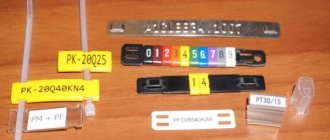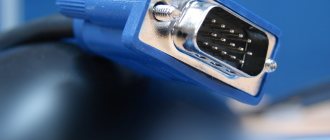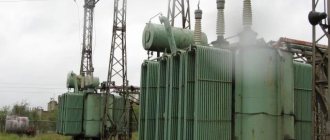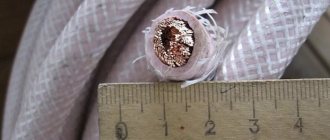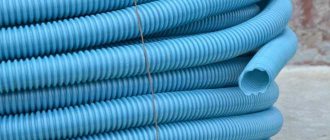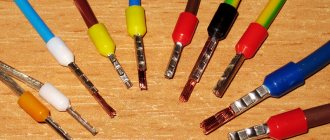Home Designations of cable and wire brands
| Serial number of letters and numbers | Designation in this letter number | Decoding the letter |
| 1st letter | Material from which the core is made | A – aluminum core; AS – the same, lead sheath; AA – the same, aluminum shell; No letter - copper wire |
| 2nd letter | Scope of application of cable, wire, cord | B – onboard aircraft wires; K – control cable; KG – flexible cable; G – mountain cable; M – installation cable, wire; P – wire; PP – flat wire; No letter – power cable; O – optical; U – installation cable; Ш – cord; ШБ – household cord; E – for special mine conditions |
| 3rd letter | Indicates the degree of flexibility | G – flexible, multi-wire; The letter G is missing - the core is single-wire. |
| 4th letter | Core insulation material | B – polyvinyl chloride (PVC); P – polyethylene; R – rubber; NR – non-flammable rubber; F – fluoroplastic; C – film insulation (for installation wires); For winding wires: EV – high-strength enamel; EL – varnish-resistant enamel; ET – heat-resistant enamel; B – cotton yarn; K – nylon; Ш – natural silk; ShK – artificial silk nylon; C – glass insulation; A – asbestos insulation; O – one layer of insulation (maybe the 4th letter); |
| 5th letter | Cable sheath material, armor | BBG – armor made of steel profiled tape; BN - armor made of steel strips, with a protective cover that does not support combustion; B – PVC; D – double wire; K – armor made of round galvanized steel wires, enclosed in a protective cover; SB - lead armor; |
| 6th letter | Type of protective cover. Purpose of the outer layer, designation of the core structure | B – PVC; B – paper insulation (at the end of the designation); G – anti-corrosion protective layer; Absence of the letter G – protection from mechanical damage; O – insulated conductors are combined into a common sheath, braid (for wires); Shv – protective layer (or shell) – pressed PVC hose; Shp - the same, but made of polyethylene; Shps - the same, but made of self-extinguishing polyethylene; E – shielded; BN - armor made of steel strips with a protective cover that does not support combustion; T – wire is intended for installation in pipes; |
| The last letters in the designation | Design features, climate control, etc. | U – paper insulation with increased heat resistance; P – flat design; HL – cold resistance; T – increased resistance to thermal effects; LS – reduced smoke and gas emissions |
| Capital letters | Placed next to capital letters | c - vulcanized (polyethylene); d – water blocking tapes (used to seal a metal screen); h – filling between the cores; ng – shell made of non-combustible material; b – without a pillow; l – the pillow contains lavsan tape; 2l - the same, but double lavsan ribbon; s – self-extinguishing |
| 1st digit | Rated voltage | 1 – rated cable voltage (example), kV; If there is no number, use a low-voltage cable up to 660 V; |
| 2nd digit | Number of cores | 1- 4 – power cables; 2-14 – installation cables; 4-37 – control cables |
| 3rd digit | Core cross-section, mm² | 0.75-10 – control cables 0.35 – 0.75 – installation cables |
Examples of decoding power cables
- VVG-1.5-2 is a copper power cable in polyvinyl chloride insulation in a PVC sheath, having an anti-corrosion protective layer, in which two cores have a cross-section of 1.5 mm².
- AVBBShv-1 4x150 ozh: power cable with aluminum conductors in PVC insulation, armored with two galvanized steel strips without a softening cushion, the sheath has the appearance of a protective PVC hose. The cable is designed for a rated voltage of up to 1 kV, has four single-wire cores of 150 mm² each.
- VEVG - 6 - 1x16(ozh) - power cable in polyvinyl chloride insulation, shielded, covered with anti-corrosion material, designed for a rated voltage of 6 kV and having one single-core core with a cross-section of 16 kV. mm.
- KGVP - cable is intended for power supply of mobile lifting and transport, loading and unloading mechanisms at a rated voltage of up to 380/660 Volts inclusive alternating current frequency 50Hz and 500 Volts DC.
Examples of decoding cable markings
VVG cable - 2x1.5. It stands for: power cable sheathed in polyvinyl chloride (PVC). The shell is covered with an anti-corrosion layer. Consists of two copper wires with a cross section of 1.5 mm2.
Its subtype - VVGp - is the same, only in a flat design. VVGng - the cable sheath does not support combustion.
Cable VBBShvng. The decoding of this abbreviation is as follows: copper conductors (there is no letter A). The core insulation is made of PVC, the BB armor is made of two steel strips, without a protective pad. Cable protective cover - Shvng - pressed-out PVC hose of low flammability.
KG cable. The decoding of the letter designation is as follows. Copper conductors, flexible cable. That's all. Wires without insulation, if there is also the letter “n” - KGn - the cable sheath is made of non-flammable oil-resistant rubber.
This is what the KG cable looks like
How to decrypt APvPu2g? Cable with aluminum conductors (first letter A), wire insulation made of cross-linked polyethylene (Pv), cable sheath made of reinforced polyethylene (Pu), double waterproofing (2g). In this case, aluminum polymer tape is used in combination with longitudinal waterproof tapes.
KSPV cable. This stands for: cable (K), transmission systems (SP) in a vinyl sheath (B). That is, this is not a power cable, but is used to transmit various data (low-current). The conductors are copper - since there is no letter “A”.
Products AABL. The decoding is as follows: aluminum wires (A), aluminum shell (A), covered with armor made of two steel tapes (Bl), under the armor there is a protective cushion made of plastic tapes.
APvPu - aluminum conductors (A), insulation made of cross-linked polyethylene (Pv), reinforced sheath made of polyethylene (Pu).
MKESH - installation cable (MK), shielded (E), in a protective PVC hose.
Examples of decoding control cable brands
- KSBG -4x1.5+1x1.0 – control cable in a lead sheath, armored, anti-corrosion coating, has four cores with a cross-section of 1.5 square millimeters and one of 1 square millimeter. mm.
- AKVVG is a control cable with aluminum conductors in polyvinyl chloride insulation in a PVC sheath, with an anti-corrosion coating.
- KVBBShVng-LS 4x2.5 control cable with copper cores, four cores with a cross-section of 2.5 square millimeters, is intended for fixed connection to electrical devices with voltages up to 660 Volts.
Conductor conductor (TCC)
The main element of the cable's current-carrying cores is soft copper wire. The conductive cores are twisted from 7 (cross-section 0.75 mm2 and less) or 19 wires (cross-section over 0.75 mm2). The choice of the number of elementary wires is determined by obtaining a geometrically correct layered twist of the core, when the number of wires in the outer layer is 6 more than in the inner layer. The core is twisted according to the system (1+6) or (1+6+12).
Designations of types of veins:
SM - steel-copper conductor. It is mainly used in cables for perforation work in wells. With a seven-wire TPG design, steel and copper wires are twisted in one layer; when using a 19-wire TPG, copper and steel wires are arranged in separate layers;
ML - TPG made of tinned copper wire;
MN - TPG made of nickel-plated copper wire. Used for high temperature cables with fluoropolymer insulation to prevent copper oxidation under high temperatures.
C - TPG made of steel wires.
Isolation of TPG.
The insulation of geophysical cables mainly determines the temperature resistance of the cable. Currently, the following materials are used for insulation of TPG: - low-density polyethylene (HDPE), block copolymer of propylene with ethylene (polypropylene), ETFE - TefzelTM or Russian analogue fluoroplastic 40Ш2, FEP - TeflonTM or Russian analogue - fluoroplast 4MB, PFA - Teflon TM or Russian analogue of fluoroplastic 50, PTFE - TeflonTM.
From the comparative qualitative characteristics of the materials it is clear that while polyethylene and polypropylene are practically identical, polyethylene has lower temperature resistance. Therefore, the Pskovgeokabel enterprise has not used low-density polyethylene as an insulating material since 2002. For the same reason, our price list does not include brands with a temperature index of 900C. However, at the request of the conservative part of consumers, we are always ready to make cable insulation from this material; the cost of the cable will be the same as for cables with an operating temperature of 1500C.
Winding.
The cable core winding is used to fasten the core elements. Depending on the cable design, various tape materials are used: from .
| Technical requirements | |||||
| Brand Type KGL 1x0.35-10-130 | Number and nominal cross-section of cores | Core resistance no more | Breaking force no less | Maximum operating temperature | Purpose |
| MM | Ohm/km | kN | °С | ||
| KGL 1x 0.75-20-130 | For geophysical research and work in wells with temperatures up to +1300C | ||||
| KGL 1x 0.75-28-130 | |||||
| KGL 1x 0.75-30-130 | |||||
| KGL 3x 0.35-38-130 | |||||
| KG 1-55-130-SM | |||||
| KG 7x0.75-75-130 | |||||
| KG 1x0.75-55-130 | |||||
| KG 1x1.5-55-130 | |||||
| KG 3x0.75-60-130 | |||||
| KG 7x0.75-75-130 | |||||
| KGL 1x0.35-10-150 | |||||
| KGL 1x 0.75-20-150 | |||||
| KGL 1x 0.75-28-150 | |||||
| KGL 1x 0.75-30-150 | |||||
| KGL 3x 0.35-38-150 | |||||
| KG 1-55-150-SM | |||||
| KG 1x0.75-55-150 | |||||
| KG 3x0.75-60-150 | |||||
| KG 7x0.75-75-150 | |||||
| KGL 1x0.35-10-180 | |||||
| KG 1x0.75-55-150 | |||||
| KGL 1x 0.75-20-180 | |||||
| KGL 1x 0.75-28-180 | |||||
| KGL 1x 0.75-30-180 | |||||
| KGL 3x 0.35-38-180 | |||||
| KG 1-55-180-SM | |||||
| KG 1x0.75-55-180 | |||||
| KG 1x1.5-55-180 | |||||
| KG 3x0.75-60-180 | |||||
| KG 7x0.75-75-180 | |||||
| KG 3x0.75-60-130-K | |||||
| KGN 1х6-60-130 | |||||
| KGSv 1x0.75-95-130 | |||||
| KG 3x0.75-160-130-4 | |||||
| KG 3x0.75-160-150-4 | |||||
| KG 3x0.75-160-180-4 | |||||
| KL 3-120-130 GS |
Wire armor
General provisions.
The geophysical cable is armored with several layers of round galvanized steel wires laid in layers. The direction of the twists is right for odd numbers, left for even numbers. The bulk of the cables have a two-strand design. The armor wires are applied in increments equal to (7.5±1) the nominal outer diameter of the layer.
Wire strand filling coefficient.
An important criterion for the performance of a geophysical cable is the density of filling the wire strand, i.e. the ratio of the sum of the cross sections of the wires of a layer to the total length of the circle drawn through the centers of the wires of the same layer. The industry standard sets this figure at no less than 92%, but the experience of manufacturing armored cables and consumer reviews determines a more stringent internal standard of our enterprise - a fill factor of 98.6–99.5%. This indicator is especially important for lubricator cables operating through a gland device at high wellhead pressure.
Control questions
- Purpose of logging cable.
- Operating conditions for logging cables.
- What are the requirements for a logging cable?
- What types of logging cables do you know?
- Design, mechanical and electrical parameters of armored cables
- Design, mechanical and electrical parameters of braided and hose cables.
- Advantages of armored cables compared to braided and hose cables
Laboratory work No. 4
“Determination of the type of fault in the logging cable. Finding places of leaks, breaks, damage to armor and cable insulation"
Purpose of work: To teach how to determine the type of fault in a logging cable.
Class equipment:
Work plan:
Report design plan.
Based on the results of the work performed, prepare a report containing:
1. topic of work;
2. purpose of the work;
3. work execution plan;
Work order:
Interpretation of wires used for overhead power lines
- SIP is a self-supporting insulated wire insulated with cross-linked polyethylene, resistant to light.
- SIP-1 – with uninsulated neutral.
- SIP-2 – with insulated neutral.
- SIP-4 - the cores have the same cross-section.
- A – uninsulated, consisting of twisted aluminum wires.
- AC is a bare wire consisting of a steel core and aluminum wires.
Optical cable marking translator
Cable brand:
DKP, DKPa - in the ground, armored with chipboard wires, DSN - in the ground, armored with glass rods DS, DSS - self-supporting DT, DD - suspended with a cable DBP, DPb - in the sewer, armored with steel tape DP - for installation in pipes, unarmored
x1. Type of optical core (OS):
D - fully dielectric C - with a steel central element
x2. Cable design by type of reinforcing elements:
K – round steel wires B – corrugated steel tape (design using an intermediate sheath) C – dielectric peripheral power elements (in a self-supporting cable – high-modulus reinforcing threads or armor made of fiberglass rods) Сс – dielectric peripheral power elements in a self-supporting cable – glass fibers T – with built-in support cable, wire D – with built-in dielectric support element, number “2” – number of elements
x3. Type of outer cable sheath:
P – polyethylene; H – flame retardant polymer material, the designation of the shell type may be indicated in brackets (HF) – flame retardant polymer material, halogen-free, (LS) – flame retardant polymer material, halogen-free, low smoke emission and etc.; Pa – polyethylene with an additional aluminum shell; Na is a flame retardant polymer material with an additional aluminum shell. PS – polyethylene, reinforced with steel wires NS – flame retardant polymer material, reinforced with steel wires PB – polyethylene with an additional sheath of corrugated steel tape (lightweight design, without an internal intermediate shell) Nb – flame retardant polymer material with an additional sheath of steel corrugated tape Pbs - polyethylene with an additional sheath of corrugated steel tape and reinforced with round steel wires n - flame retardant polymer material (index for cables of type DS, DT, DD)) t - tracking-resistant sheath (index for cables of type DS, DD , DP) p – repellents have been added to protect against rodents
x4. Tensile load
x5. Fiber type
0 – Multimode OF with a core diameter of 62.5 μm or more 1 – Multimode OF with a core diameter of 50 μm OM-2 M3, M4, fM3, fM4 – Multimode OF LaserWave 300 OM-3, OM-4 (ISO 11801) with a diameter 50 µm core and also bend resistant (f) 5 – Single-mode OF with non-zero dispersion shift in the range of 1550 nm (ITU-T Recs G.655A/B/C/D and ITU-T G.656) 6z – Single-mode OF G.652D. 6f – Single-mode bend-resistant G.652 D and G.657A2/B2 6R – Single-mode bend-resistant with nominal outer diameter of the protective coating 200 µm G.652 D and G.657A 7 – Combination of different types of fiber in one cable. 9z – Single-mode low-attenuation and bend-resistant G.652 D and G.657 A1
x6. Number of elements in twist
x7. Total number of fibers
Designation of some brands of foreign cables and wires
Power cable:
- N – the cable is manufactured according to the German VDE standard (Union of German Electrical Engineers).
- Y – Polyvinyl chloride insulation.
- H – Absence of halogens (harmful organic compounds) in PVC insulation.
- M – Installation cable.
- C – Availability of copper screen.
- RG – Availability of armor.
Control cable:
- Y – PVC insulation.
- SL – Control cable.
- Li – Stranded conductor made according to the German VDE standard.
Mounting wires:
- H – Harmonized wire (HAR approval).
- N – Compliance with national standard.
- 05 – Rated voltage 300/500 V.
- 07 – Rated voltage 450/750 V.
- V – PVC insulation.
- K – Flexible core for stationary installation.
Examples of decoding foreign-made cables
NYM - power cable with copper cores, insulated cores of multi-core cables are twisted in PVC insulation, belt insulation made of unvulcanized rubber compound (single-core cables without belt insulation), gray PVC sheath.
Theoretically, the brand of cable, wire or cord, if you look at the table, includes seven to eight letters, not counting the numbers. But in reality, when designating brands of cable products, fewer letters are used. This is explained by the fact that some letters are not included, for example, in the designation of a copper core, the absence of armor or protective cover.
For detailed information about cable and wire products, please call 204-52-86, 204-52-91
The previous article dealt with deciphering paper-insulated cables. Below is a breakdown of the markings for cables with plastic insulation.
- Explanation of markings
- How VVG cables are decrypted
- Cable marking table
- Connection and termination of cables
Advantages of plastic insulation of power cables
Plastic as an insulating material simplifies the manufacture, laying and installation of power cables. Plastic cable insulation is most often made of PVC or XLPE (cross-linked polyethylene).
Polyethylene is well suited for insulating high-voltage cables:
- the operating temperature range is greater than that of wires with other types of insulation;
- environmental safety: the cable can be laid at any facility, cable lines can be used with virtually no maintenance;
- resistance to acids, alkalis and moisture;
- installation and cable laying work is carried out without additional heating with a bending radius of up to 15 outer diameters and with a single bend - up to 7.5 at temperatures from -15 to -20°C;
- equal ease of installation in different areas: both on complex routes and in cable structures;
- strength: damage resistance is several orders of magnitude lower when compared with paper insulation;
- The cable can be laid over rough terrain.
The dielectric properties of XLPE are quite high. The density of polyethylene depends on the manufacturing method. Thus, high-density XLPE has good mechanical resistance and a high melting point. It loses its elasticity at temperatures above 140°C, and low-density - already at 105°C.
Additions of organic peroxides and further vulcanization make XPE resistant to cracking and increase the melting point.
Decoding the markings of power cables with plastic insulation.
Let's move directly to the issue of marking cables with plastic insulation.
The letter a
" at the beginning of the cable marking indicates that the conductor is made of
aluminum
.
Such cables include A
VVG,
A
pvBBShng and others. The absence of the letter “A” indicates that the insulation is copper (VVG, PvVGng).
The next letter in the cable name indicates phase insulation (inner sheath). There are 3 options here:
- “ V
” (“
inil
”): insulation made of PVC plastic (A
V
VGng,
V
bbShng, etc.), - “ P
” (“
polyethylene
”): insulation from a halogen-free non-flammable composition (PPGng-HF, PBbPng-HF), - “ Pv
” (“
ulcanized
polyethylene ” ): insulation made of cross-linked polyethylene (A
Pv
VG, PvBVng-LS).
The next letter indicates a shell made of polymer materials. Letter " B
" means that this is an outer shell made of PVC plastic (V
V
Gng, ApvVGng-LS), "
P
" (“
polyethylene
”) - the insulation consists of a halogen-free non-flammable composition (PPGng-HF, PBbPng-HF). The absence of these letters in the cable name indicates the absence of this sheath (APvBbShng, PvPGng-HF).
Letters " BB"
"indicate the presence of
armor
made of two non-galvanized or galvanized steel tapes on the cable (Apv
BB
Shng, VBBShvng-LS).
The name of a cable without an outer covering contains the letter “ G
” (“naked”): VV
G
ng, AVVGng-LS.
The remaining letters refer to the hose type cover. Pokrov sh
lang type made from PVC plastic is designated by the letters “
Shv
” (VBB
Shv
, PvBB
Shv
), from
non
- flammable
PVC plastic – “
ng
” (like heat-shrinkable tubes).
Cables made of non-flammable plastic with low gas and smoke emissions have the abbreviation “ng-LS” (ApvVGng-LS, ApvBVng-LS) in the name. « L.S.
the
cable is translated as "
Low
S moking" - reduced smoke emission.
For convenience, below is a table with a breakdown of the names of cables with plastic insulation.
Power cable VVG - decoding of markings
Next, let's look at the decoding of the markings of perhaps the most popular VVG
and its modifications: VVGng, VVGng-LS, VVGng A-LS. For what purposes are cables with polyvinyl chloride insulation used, and what do the letters in the abbreviations indicated in the marking mean?
- Main characteristics
- Decoding the markings of VVG power conductors
General information about the cable
The cable marked VVG is perhaps the most frequently used in the implementation of energy supply, and specifically for the transmission and distribution of electrical energy in the open air, inside residential and non-residential premises, as well as industrial buildings and structures. In addition to the above objects, this cable is used in power plants, collectors, lighting devices, cable racks, etc.
VVG cable
Main characteristics
Of the main characteristics, we note that the rated alternating voltage range for the VVGng cable is up to 1000 Volts at a nominal frequency of 50 Hz. The conductor can have from 1 to 5 copper or aluminum conductors, with or without the presence of a neutral conductor. The VVG cross-sectional area also has an acceptable range from 1.5 to 240 mm².
The warranty period of the product is at least 5 years, and the actual service life is about 30 years. The ambient temperature during cable operation should not exceed the range from -50°C to 50°C. But during cable laying, the lower threshold of the ambient temperature should not be lower than 15 °C.
Decoding the markings of VVG power conductors
Cable marked as VVG
, consists of copper wires.
This is indicated by the absence of the letter “ A
” at the beginning of the abbreviation.
Thus, the first letter “ B
” means the presence of core insulation made of polyvinyl chloride plastic.
By the second letter “ B
”, it is determined that the outer sheath of the cable is also made of PVC.
And the letter “ G
” makes it clear that there is no protection (armor) in this cable and it is
flexible
.
The VVGng cable is marked with the letters “ ng
"indicate the content of halogen particles in PVC insulation, due to which the conductor does not support combustion.
Cable with low smoke emission during combustion of insulating materials, marked as VVGng LS (LS)
.
In addition to the fact that this cable has a reduced fire hazard, when the sheath and insulation melts as a result of combustion, it emits a minimal amount of smoke and toxic gases. The abbreviation “ LS
” stands for “Low Smoke”.
In the conductor of the VVGng-FRLS brand, the letters FR
(Fire Resistance) means that the design contains a thermal barrier in the form of a mica-containing tape, which allows it to be classified as fire-resistant. Such a cable maintains the integrity of the cores at temperatures up to 750°C for at least 180 minutes.
Cable VVGng-FRLS
VVGEng-FRLS differs from VVGng-FRLS by the presence in its design of a screen made of copper tape or foil to strengthen internal insulation, protect against aggressive substances, and reduce the impact of electrical potentials on external insulation.
Cable VVGEng-FRLS
Among the VVG varieties with reduced smoke and gas emissions, we note the VVGng (A) LS brand. This cable is intended for use in buildings and premises with fire safety class A
(increased fire hazard). And in explosive zones, classes B1 and B1-a, for example in nuclear power plant systems.
Marking table for power cables with plastic insulation.
Decoding the markings of a power cable with plastic insulation
| Cable marking | core material | phase insulation | shell made of polymer materials | armor | without outer covering over armor or shell | outer cover | ||||||||
| copper | aluminum | made of PVC plastic | made of halogen-free, non-flammable composition | made of vulcanized PE | made of PVC plastic | made of halogen-free, non-flammable composition | made of 2 non-galvanized or galvanized steel strips | hose type cover | ||||||
| W or H | ||||||||||||||
| made of PVC plastic | from PE | made of non-flammable PVC plastic | made of non-flammable PVC plastic with low smoke and gas emissions | made of halogen-free non-flammable composition | ||||||||||
| used | A | IN | P | Pv | IN | P | BB | G | V | P | ng | ng-LS | ng-HF | |
| AVVG | A | IN | IN | G | ||||||||||
| VVG | IN | IN | G | |||||||||||
| APvVG | A | Pv | IN | G | ||||||||||
| PvVG | Pv | IN | G | |||||||||||
| AVBbShv | A | IN | BB | Shv | ||||||||||
| VBBShv | IN | BB | Shv | |||||||||||
| APvBbShv | A | Pv | BB | Shv | ||||||||||
| PvBbShv | Pv | BB | Shv | |||||||||||
| APvBbShp | A | Pv | BB | Shp | ||||||||||
| PvBbShp | Pv | BB | Shp | |||||||||||
| AVVGng | A | IN | IN | G | ng | |||||||||
| VVGng | IN | IN | G | ng | ||||||||||
| APvVGng | A | Pv | IN | G | ng | |||||||||
| PvVGng | Pv | IN | G | ng | ||||||||||
| AVBbShng | A | IN | BB | Shng | ||||||||||
| VBBShng | IN | BB | Shng | |||||||||||
| APvBbShng | A | Pv | BB | Shng | ||||||||||
| PvBbShng | Pv | BB | Shng | |||||||||||
| AVVGng-LS | A | IN | IN | G | ng-LS | |||||||||
| VVGng-LS | IN | IN | G | ng-LS | ||||||||||
| APvVGng-LS | A | Pv | IN | G | ng-LS | |||||||||
| PvVGng-LS | Pv | IN | G | ng-LS | ||||||||||
| AVBbShvng-LS | A | IN | BB | Shvng-LS | ||||||||||
| VBBShvng-LS | IN | BB | Shvng-LS | |||||||||||
| APvBVng-LS | A | Pv | B | Vng-LS | ||||||||||
| PvBVng-LS | Pv | B | Vng-LS | |||||||||||
| VBVng-LS | IN | B | Vng-LS | |||||||||||
| AVBVng-LS | A | IN | B | Vng-LS | ||||||||||
| PPGng-HF | P | P | G | ng-HF | ||||||||||
| PBbPng-HF | P | BB | PNG-HF | |||||||||||
| PvPGng-HF | Pv | P | G | ng-HF | ||||||||||
Heat-shrinkable sleeves for connection and termination
During installation and repair work, quite often a situation arises when it is necessary to make a cable connection. Traditionally there are: twisting, soldering, terminal blocks and spring terminals. In the case where the cross-sectional area of the cable is 20 mm² or more, these methods will no longer be appropriate, since the quality of the connection will either be low or it will be technologically impossible to make the connection. To connect and terminate such cables, we recommend connection and end heat-shrinkable couplings up to 1 kV.
This product is intended for connecting and terminating multi-core power cables with insulation made of PVC, PVC plastic, plastic, polymers, polyethylene, rubber with and without armor.
Couplings are supplied as a set of parts and materials.
Find out more details and get advice on heat-shrinkable couplings from the METTATRON Group
, You can by phone
We recommend that you take a responsible approach to choosing cable products to suit your needs. Before ordering, study the labeling of the required products and consult with the manufacturer. Our company’s specialists are ready to provide the necessary advice in choosing heat-shrinkable materials and cable accessories. To do this, just call 8 (495) 135-13-11 during business hours.
